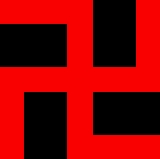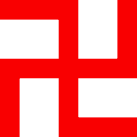
Sauwastika
Encyclopedia

Swastika
The swastika is an equilateral cross with its arms bent at right angles, in either right-facing form in counter clock motion or its mirrored left-facing form in clock motion. Earliest archaeological evidence of swastika-shaped ornaments dates back to the Indus Valley Civilization of Ancient...
symbol, a meaning which developed in 19th century scholarship.
The "left-facing" variant is favoured in Bön and Gurung Dharma
Gurung Dharma
Gurung Dharma describes the traditional shamanistic religion of the Gurung people of Nepal. This religion shares aspects with the Tibetan religion Bön and is often referred to as "Bön"; however, there exist significant distinctions between Gurung Dharma and Bön...
; it is called yungdrung in Bon and Gurung Yantra in Gurung Dharma. Both the right-facing and left-facing variants are commonly employed in Hinduism
Hinduism
Hinduism is the predominant and indigenous religious tradition of the Indian Subcontinent. Hinduism is known to its followers as , amongst many other expressions...
and Buddhism
Buddhism
Buddhism is a religion and philosophy encompassing a variety of traditions, beliefs and practices, largely based on teachings attributed to Siddhartha Gautama, commonly known as the Buddha . The Buddha lived and taught in the northeastern Indian subcontinent some time between the 6th and 4th...
.
Etymology
SanskritSanskrit
Sanskrit , is a historical Indo-Aryan language and the primary liturgical language of Hinduism, Jainism and Buddhism.Buddhism: besides Pali, see Buddhist Hybrid Sanskrit Today, it is listed as one of the 22 scheduled languages of India and is an official language of the state of Uttarakhand...
sauvastika is the vṛddhi
Vrddhi
' is a Sanskrit word meaning "growth" . In Panini's grammar, it is also a technical term for a group of long vowels. In Indo-European linguistics, it has become a term for the lengthened grade of the ablaut vowel gradation peculiar to the Indo-European languages...
of svastika, attested as an adjective meaning "benedictive, salutatory". The connection to a "reversed" svastika is probably first made by Eugène Burnouf
Eugène Burnouf
Eugène Burnouf was an eminent French scholar and orientalist who made significant contributions to the deciphering of Old Persian cuneiform....
in 1852, and taken up by Schliemann
Heinrich Schliemann
Heinrich Schliemann was a German businessman and amateur archaeologist, and an advocate of the historical reality of places mentioned in the works of Homer. Schliemann was an archaeological excavator of Troy, along with the Mycenaean sites Mycenae and Tiryns...
in Ilios (1880), based on a letter from Max Müller
Max Müller
Friedrich Max Müller , more regularly known as Max Müller, was a German philologist and Orientalist, one of the founders of the western academic field of Indian studies and the discipline of comparative religion...
, who is in turn quoting Burnouf. The term sauwastika is used in the sense of "backwards swastika" by D'Alviella (1894):
The term has been misspelled as suavastika, a term attributed to Max Müller by Wilson (1896).
Wilson finds that "The 'Suavastika' which Max Müller names and believes was applied to the Swastika sign, with the ends bent to the left [...] seems not to be reported with that meaning by any other author except Burnouf."
Claims of a distinction in Indian religions


Eugène Burnouf
Eugène Burnouf was an eminent French scholar and orientalist who made significant contributions to the deciphering of Old Persian cuneiform....
, the first Western expert on Buddhism, stated in his book Lotus de la bonne loi (1852) that the Sauvastika was a Buddhist variant of the Svastika.
When Heinrich Schliemann
Heinrich Schliemann
Heinrich Schliemann was a German businessman and amateur archaeologist, and an advocate of the historical reality of places mentioned in the works of Homer. Schliemann was an archaeological excavator of Troy, along with the Mycenaean sites Mycenae and Tiryns...
discovered swastika motifs in Troy
Troy
Troy was a city, both factual and legendary, located in northwest Anatolia in what is now Turkey, southeast of the Dardanelles and beside Mount Ida...
, he wrote to the Indologist Max Müller
Max Müller
Friedrich Max Müller , more regularly known as Max Müller, was a German philologist and Orientalist, one of the founders of the western academic field of Indian studies and the discipline of comparative religion...
, who, quoting Burnouf, confirmed this distinction, adding that "the Svastika was originally a symbol of the sun, perhaps of the vernal sun as opposed to the autumnal sun, the Sauvastika, and, therefore, a natural symbol of light, life, health, peace and wealth." The letter was published in Schliemann's book Ilios (1880):
The term sauvastika thus cannot be confirmed as authentic and is probably due to Burnouf (1852). Notions that sauwastikas are considered "evil" or inauspicious versions of the auspicious swastika in Indian religions have even less substance, since even Burnouf counts the svastika and the sauvastika equally among the "sixty-five auspicious signs".
D'Alviella (1894) voices doubts about the distinction:
Although the more common form is the right-facing swastika, the symbol is used in both orientations for the sake of balance in Hinduism
Hinduism
Hinduism is the predominant and indigenous religious tradition of the Indian Subcontinent. Hinduism is known to its followers as , amongst many other expressions...
. Buddhists almost always use the left-facing swastika.
Claims concerning the Nazi swastika
Some contemporary writers assert that the swastika as used in Nazi GermanyNazi Germany
Nazi Germany , also known as the Third Reich , but officially called German Reich from 1933 to 1943 and Greater German Reich from 26 June 1943 onward, is the name commonly used to refer to the state of Germany from 1933 to 1945, when it was a totalitarian dictatorship ruled by...
is in fact the "evil sauwastika". Since the swastika on the Flag of Nazi Germany was "right-facing" when displayed one-sided (e.g. hanging on buildings), this requires a redefinition of "sauwastika" as the variant current in Hinduism, and the "swastika proper" as the "left-facing" one current in Buddhism, contrary to Burnouf. The notion that Hitler deliberately inverted the "good left-facing" Buddhist swastika is, however, wholly unsupported by any historical evidence.
See also
- Bön
- LauburuLauburuThe lauburu or Basque cross has four comma-shaped heads similar to the Japanese tomoe. It can be constructed with a compass and straightedge, beginning with the formation of a square template; each head can be drawn from a neighboring vertex of this template with two compass settings, with one...
- Sun crossSun crossThe sun cross, also known as the wheel cross, Odin's cross, or Woden's cross, a cross inside a circle, is a common symbol in artifacts of the Americas and Prehistoric Europe, particularly during the Neolithic to Bronze Age periods.-Stone Age:...
- TriskelionTriskelionA triskelion or triskele is a motif consisting of three interlocked spirals, or three bent human legs, or any similar symbol with three protrusions and a threefold rotational symmetry. Both words are from Greek or , "three-legged", from prefix "τρι-" , "three times" + "σκέλος" , "leg"...
- SwastikaSwastikaThe swastika is an equilateral cross with its arms bent at right angles, in either right-facing form in counter clock motion or its mirrored left-facing form in clock motion. Earliest archaeological evidence of swastika-shaped ornaments dates back to the Indus Valley Civilization of Ancient...
- Western use of the Swastika in the early 20th centuryWestern use of the Swastika in the early 20th centuryThe swastika is an equilateral cross with its arms bent at right angles, in either right-facing form or its mirrored left-facing form. Archaeological evidence of swastika-shaped ornaments dates from the Neolithic period and was first found in the Indus Valley Civilization of the Indian...
- ValknutValknutThe Valknut is a symbol consisting of three interlocked triangles, and appears on various Germanic objects. A number of theories have been proposed for its significance....
- Gurung DharmaGurung DharmaGurung Dharma describes the traditional shamanistic religion of the Gurung people of Nepal. This religion shares aspects with the Tibetan religion Bön and is often referred to as "Bön"; however, there exist significant distinctions between Gurung Dharma and Bön...

